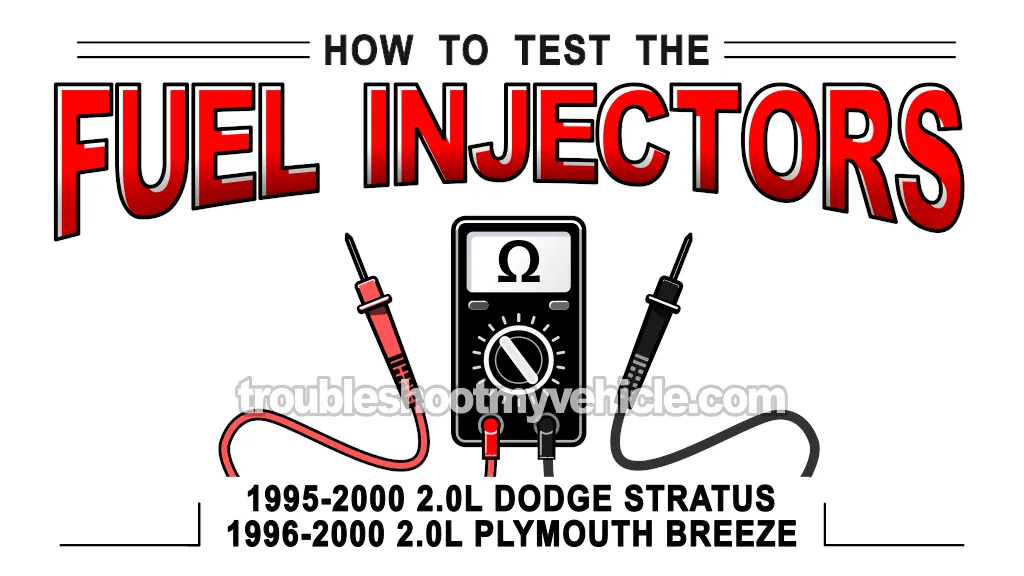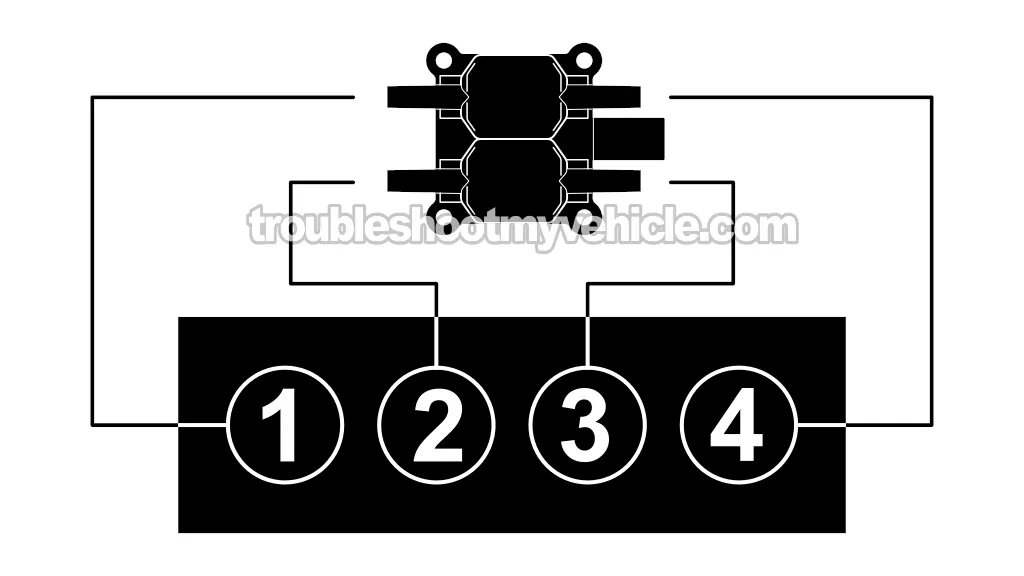
Testing the fuel injectors on the 1995-2000 2.0L Dodge Stratus or Plymouth Breeze isn't hard to do at all. What makes it so easy is just how accessible they are.
In this tutorial, I'll walk you through the steps to determine if an internal electrical issue is preventing your injectors from delivering fuel to their respective cylinders. With your test results, you'll easily find out if you've got a bad injector on your hands.
I'm also going to share with you my fuel injector diagnostic strategy for locating a clogged fuel injector (or the real cause of the cylinder misfire).
Contents of this tutorial:
APPLIES TO: This tutorial applies to the following vehicles:
- 2.0L Dodge Stratus: 1995, 1996, 1997, 1998, 1999, 2000.
- 2.0L Plymouth Breeze: 1996, 1997, 1998, 1999, 2000.
Symptoms Of A Bad Fuel Injector
In my experience, fuel injectors typically fail in one of two ways. Either they get clogged, in which case they're unable to spray fuel in a proper pattern —known as atomizing.
Or they suffer an internal electrical issue due to wear and tear, leading to a complete halt in fuel injection into the cylinder.
Regardless of the failure type, you'll likely notice one or more of these symptoms:
- Rough idle.
- Lack of power.
- The engine hesitates when you accelerate under load.
- Cylinder misfire trouble codes:
- P0300: Random Cylinder Misfire.
- P0301: Misfire In Cylinder #1.
- P0302: Misfire In Cylinder #2.
- P0303: Misfire In Cylinder #3.
- P0304: Misfire In Cylinder #4.
Although the focus of this tutorial is testing the fuel injectors for an internal electrical issue, determining if a fuel injector is clogged isn't that difficult. I'll share my diagnostic strategy in this section: How To Find The Bad Or Clogged Fuel Injector.
Checking The Resistance Of The Fuel Injectors
Before we begin the test, we need to remove anything that might obstruct access to the fuel injectors. Once all the fuel injectors are exposed, we'll disconnect them from their connectors.
Then, using a multimeter set to Ohms mode, we'll measure the internal resistance of each injector. If a fuel injector has an internal electrical issue, its resistance will outside the specified range of 10 to 16 Ohms (Ω).
To accurately check this resistance, ensure your Dodge Stratus (or Plymouth Breeze) is at room temperature, meaning the engine should be cold. So, if the engine has been running for any length of time, let it cool down completely before beginning.
Here are the test steps:
- 1
Disconnect the fuel injectors from their electrical connectors.
NOTE: To identify which cylinder the fuel injector belongs to, see the illustration above with the cylinder numbers for the 2.0L engine. - 2
Set the multimeter to its Ohms (Ω) function.
- 3
Measure the fuel injector's resistance across its two male terminals with the multimeter probes (see the illustration above).
- 4
Record the resistance value that your multimeter shows for the specific fuel injector you're testing.
The illustration above will help you identify the cylinder number to which the fuel injector belongs. - 5
Repeat steps 1 to 3 for the remaining fuel injectors.
NOTE: The resistance specification is: 10 to 16 Ohms.
Let's find out what your test results mean:
CASE 1: All fuel injector resistances are within the specified value. This is the expected and correct test result, and it tells you that none have an internal short-circuit or open-circuit problem.
If you suspect a clogged fuel injector (that the resistance test can't detect), proceed to the next section: How To Find The Faulty Or Clogged Fuel Injector.
CASE 2: One of the fuel injectors recorded a resistance value that's not within specification. This indicates that the fuel injector is faulty. Replace the fuel injector.
How To Find The Bad Or Clogged Fuel Injector
Over the years, having had the chance to work on many engine performance issues, I frequently came across bad or clogged fuel injectors causing cylinder misfire issues. In some shops with state-of-the-art diagnostic tools, pinpointing a clogged or faulty fuel injector was a piece of cake.
However, in other places, I had to rely on a more hands-on, manual approach. It's this manual approach that I want to share with you. This method is especially useful if you don't have access to the expensive tools found in professional repair shops.
The essence of this approach is a process of elimination. It involves methodically testing various components that might cause a cylinder misfire. You start by testing one component, interpreting the results, and then either ruling it out or identifying it as the issue. If it's good, you proceed to the next component. This systematic testing allows you to identify a clogged or bad fuel injector, using just a few basic tools.
Here it is:
- First, find the 'dead' cylinder.
- This is the most important first step. You can do this by connecting an automotive scan tool (or code reader) and reading the fault codes stored in the fuel injection computer's memory.
- After identifying the 'dead' cylinder, make sure it's receiving spark.
- It's important to check for spark using a spark tester.
- You can find this test explained step-by-step here: How To Test The Ignition Coil (1995-2000 2.0L Dodge Stratus, Plymouth Breeze).
- Make sure that the dead cylinder's spark plug boot and the spark plug are NOT soaked (or swimming) in engine oil.
- You should also remove the spark plugs and check for cracks or carbon tracks (this is VERY important).
- Here's a real-life case study on carbon tracks and how they can cause cylinder misfire: Carbon Tracks Are A Common Cause Of Ignition Misfires (at: easyautodiagnostics.com).
- It's important to check for spark using a spark tester.
- If the 'dead' cylinder is getting spark, the next step is to make sure it has good compression.
- After ensuring the 'dead' cylinder's spark plug wire is delivering spark, you need to check for a low compression issue.
- This is one of the most overlooked tests when diagnosing a cylinder misfire or rough idle. You can find the test here:
- If the 'dead' cylinder has spark and good compression, the next step is to test the fuel injector's activation signal with a Noid light.
- If every test gives you the correct and expected result, the next step is to make sure the fuel injector is receiving its activation signal.
- The following tutorial on how to use a Noid light explains how to check for the fuel injector activation signal: (I know this isn't the most detailed article on the topic, but it should give you an idea of what's involved).
- How To Use A Noid Light And Where To Buy It (at: easyautodiagnostics.com)
- If the 'dead' cylinder has spark, good compression, and the fuel injector is being activated; the next step is to swap the fuel injector.
- If I find that I have a specific 'dead' cylinder and:
- The ignition system isn't behind the issue.
- The compression value of that cylinder is fine (compared to the rest of the cylinders).
- The fuel injector's resistance is fine and it's being activated by the fuel injection computer...
- I think the fuel injector is clogged, I then swap that fuel injector with an adjacent one.
- If I find that I have a specific 'dead' cylinder and:

If this info saved the day, buy me a beer!




